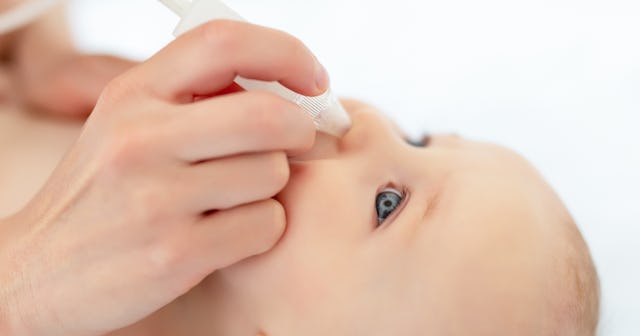Baby Congestion: What To Do, When To Worry, And When It’s Just Snot

New parenthood is exciting, scary, and all-around wonderful. But as soon as your little one is in your arms the barrage of questions crossing your thoughts is endless. How much should a newborn eat? Does my baby have kneecaps? Hey, wait! Is my baby bowlegged? Why is my baby so congested?
The latter especially is complicated as so many babies experience congestion in different ways. And let’s be real, baby congestion can be scary when a newborn sounds congested. Their airways are so tiny, and their coughs are so pitiful, it’s hard to know when it’s time to worry about your baby’s congestion and when it’s just snot. But, no need to fret. Nasal congestion in newborns is common, and cleaning a baby’s stuffy nose is a fairly straightforward affair, usually involving some snot sucker and a whole lot of gratification for the parents. (Take your fun where you can get it, people!) Here’s what you need to know.
Types of Baby Congestion
Baby congested but no mucus in the nose. Some babies might sound congested, but there’s no mucus in their nose, which is also super common. The Texas Children’s Hospital explained nasal congestion in newborns is so common they call it “nasal congestion of the newborn.” Not only do babies have tiny nostrils, but they’re also “obligate nose breathers,” which means they can only breathe through their mouth when they’re crying, making even the most infinitesimal blockage sound awful.
Baby congestion in the chest. This one is trickier. If your newborn sounds congested, is coughing or wheezing, here are a few things to try to help soothe their symptoms. Babies under four years old can’t take cough and cold medicines, so you’ll need to go the natural route here.
How can I help my congested baby sleep?
Keep babies hydrated. No matter the location of the congestion, pediatricians agree more fluids (or feedings) will keep your baby hydrated and their mucus thinned out and running, rather than hanging around.
Vaporize or mist. A cool mist vaporizer will also help moisturize the baby’s air passages. Holding a congested baby in a bathroom with a warm, steamy shower running works too.
Hold them upright or tilted. A congested baby can get relief from being held across your lap, tilted forward a bit, and patted on the back with a cupped hand, which helps them cough up any extra mucus obstructing their breathing. You can also help a congested baby sleep by holding them upright in a chair so the mucus can drain out, rather than gunk up the works.
Use a topical cough suppressant. After the steam and plenty of fluids, you can help your congested baby sleep better with a warm bath and a little Vicks BabyRub to open passageways with eucalyptus, rosemary, and lavender, or something similar. There is no shortage of essential oil recommendations online.
Give your baby warm baths. The steam and heated water helps break down mucous.
Keep allergens out of the house as much as you can. It’s important to keep the baby’s room pollutant-free, which means eliminating pet hair and the scent of burning candles and cigarettes from your home. To maintain a home with little to no allergens, do laundry and vacuum regularly. Your child’s sinuses will thank you.
Put a humidifier in your child’s room. Or spend a little time in the bathroom after running hot water.
Give your kiddo a gentle face massage. Massage their forehead, cheeks, temples, and nasal bridge to get fluids flowing and avoid congestion.
Use saline drops. Before putting your baby down for bed, drop a few saline drops into their nose. This is a natural way to break down mucus in your baby’s body. You can buy saline drops or make your own solution at home.
Pat baby’s back to help them expel mucus. Pretend you’re burping the baby, which encourages them to cough up the mucus in their throats.
When should I worry about my baby’s congestion?
If you’re concerned about whether your baby can suffocate from congestion, take them to a pediatrician. Holding them upright will make breathing easier, but if they’re struggling for breath, it’s time to worry. Seattle Children’s Hospital advises calling 911 if a congested baby is having trouble breathing, barely able to cry, or struggling for breath. They also recommend contacting 911 if the baby’s lips or face turn blue.
Call a doctor if the baby is:
- Having trouble breathing (Look out for flaring nostrils. This is a sign of labored breathing)
- Has “nonstop coughing spells”
- Bluish lips or face during coughing
- Wheezing
- Fast breathing
- Fever over 104 degrees Fahrenheit
- Your baby is high-risk due to another factor
If coughing leads to vomiting, Seattle Children’s says you can wait until office hours to see a pediatrician. But if the cough doesn’t come with any other significant symptoms or high fever, you should be OK relying on home treatments.
Can I put Vicks on my baby?
When it comes to regular Vicks, the answer is no. This may be an excellent remedy for you and your older kids, but if your child is under the age of two, they shouldn’t use it. Vicks should not be used anywhere on their bodies, including their feet or chest. The rub is too harsh for their skin and is only for children two and older. However, Vicks Baby Rub is specially formulated for babies three months and older.
This article was originally published on